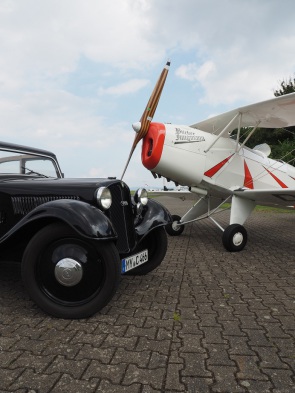
Flying fellows among themselves
The arrangement of this photo with a historical Bücker Bü 131 called “Jungmann” is not as far-fetched as it may seem at first view. As a matter of fact this DKW had really been registered at the "Fliegerhorst" (military airbase) nearby Wiesbaden since July 20th, 1939.
Admittedly, the fact that this Car has ever encountered a Bücker Jungmann on the apron of an airfield is not only very unlikely, but seems rather impossible.
The car parked where all the cars are parking: on the road. And the air plane parked where all the aircraft use to park: on the apron or in a hangar.
It is - as well - unlikely that an aristocratic pilot (as many may imagine the dream of the heroic pilots of the 1930s) should have been driven up with a DKW to his flight trainings. Usually cars of the Auto Union have indeed been very popular among the flying staff (though not exactly the "poor" F5 "Reichsklasse", but more expensive and more luxurious cars). This was confirmed by a reader of the AUVC news ("Auto Union Veteran Club" of Germany) with contemporary pictorial material in a postal communication. But the reality was much more serious: the owner of this small car was stationed at the “Fliegerhorst” in Erbenheim (part of the city of Wiesbaden) as a soldier, and the Third Reich had consistently sought out talented flight students among the young men of the fatherland by glider flying camps and all sorts of attractive enticements to win them for the "Luftwaffe" (German air force) to become a pilot.
At that time the Fliegerhorst Erbenheim near Wiesbaden was home to the Jagdgeschwader 51 (JG 51) "Mölders", what just had returned from its gloriously celebrated but highly controversial discussed Spanish operations in 1939.
World war hero Mölders was already killed as a passenger in an air crash on 21st November 1941, when he was called back home to Berlin to attend Udet's funeral, another pilot legend of the German Luftwaffe. Two simultaneous engine failures on the two-engine Heinkel He-111 he was sitting in caused an emergency landing during fog that ended deadly for him.
The composition of these pictures stands for the historical background of this DKW F5 from the year of construction 1936, but also in the context of todays German Luftwaffe. And furthermore with the Legion Condor and the very ambivalent evaluation of Werner Mölders. He was a leading German fighter ace during Spanish Civil War.
As much as a glorified view to this old car and the historical airplane may today entice, so much it contains serious reminders and hidden memories: wing commander Mölders, with totally 115 kills more successful than any other German pilot ever and highly decorated in Nazi Germany, was given command of the fighter squadron that bombed Guernica in the Basque county. Even though he was not supposed to have participated in this mission himself, he is regarded as a war criminal in today’s Germany.
The owner of the small car never dropped a bomb out of an airplane, never fired an onboard cannon or gun and never has flown a tactical aircraft, but at the "Fliegerhorst" (military airbase) - albeit under military command – he supported and maintained the german "Luftwaffe". But it shound not be forgotten, that it was nearly impossible to anyone to escape the developments in Germany as well as in other nations at that time: today it is difficult to imagine in a prosperous and (still) peaceful Europe.
The aircraft shown here is a Bücker Bü 131 "Jungmann", an absolutely contemporary standard trainer aircraft of the Luftwaffe from the 1930s. Pilots, which later flew attacks, dropped bombs, or fired the enemy, have been trained on pilot seats of these aircrafts first. Most of them were killed by the enemy or by flight accidents, only a few did survive that terrible war coming out of Germany.
The "Jungmann" pictured above belongs today to a professional pilot and Jumbo airline captain who does not have to learn flying anymore. And who is working in peaceful civil aviation.
June
First Weekend of June: DKW-Meeting at Garitz
This year, as every yaer, the 41th DKW-Meeting at Garitz, a tiny village in Saxony-Anhalt, took place.
August
First Weekend of August: Tienhoven in Holland
This year, the 44th International AUVC meeting took place in South Holland: the organizers of the Dutch DKW club praised this part of their homeland as "the most beautiful region of Holland".
In the middle of June, they had gathered more than 160 entries from 10 different countries. In the end, 222 entries had come together.
One of the visitors from England wrote as a comment: "One of the best meetings ever!" The organizers did a fantastic job, had a great time on the Saturday night... Well done to everyone that helped! The Dutch know how to create a cool event!".








